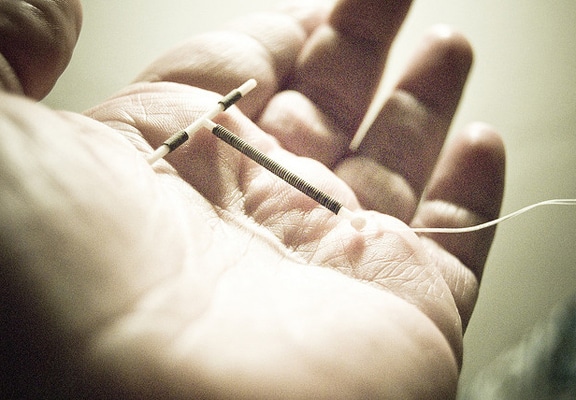
WASHINGTON (WOMENSENEWS)—Intrauterine devices, or IUDs, are among the most effective contraceptives on the market, but their high up-front costs can pose a barrier to many women.
Enter Liletta, an IUD recently approved by the U.S. Food and Drug Administration that differs from its competitors in a key regard: It was created to be affordable and accessible to all.
That’s something that Mitchell Creinen, a professor of obstetrics and gynecology at the University of California at Davis and co-author of a study on the device’s safety and efficacy, hailed at a recent women’s health conference here.
“These are the things that change the unintended pregnancy rate,” Creinen told the gathering. “This works folks. This is real. This is how we break down barriers.”
Liletta retails for $625, a price that does not include insertion and follow-up care by a professional health care provider. But certain publicly-funded clinics that serve low-income women can purchase Liletta for $50—huge savings that can be passed along to patients. That makes it more affordable and accessible for low-income women.
Liletta’s low cost was made possible through a groundbreaking partnership between Actavis (now Allergan), a global pharmaceutical manufacturer, and Medicines360, a nonprofit organization in San Francisco that works to expand access to women’s health medicines around the world. The two groups teamed up to offer women a low-cost IUD.
“Our mission is about access,” said Peter Schell, vice president for strategy and commercial at Medicines360. “Bringing this IUD to market … was about making sure that all women would be able to access this highly effective form of contraception.”
Wayne Shields, president and CEO of the Association for Reproductive Health Professionals in Washington, D.C., hailed the new product. “It’s a great thing for women,” he said.
High Unintended Pregnancy Rate
In the United States, more than half (51 percent) of all pregnancies are unplanned, according to a fact sheet by the Guttmacher Institute, a Washington, D.C.-based think tank that studies reproductive and sexual health. That’s the highest rate in the developed world, and it is growing, largely because of a steep rise in unplanned pregnancies among low-income women.
Proponents of Liletta—released in April and now available in clinics—say its low-cost will help curb the unplanned pregnancy rate. They point to the Contraceptive Choice Project, a study of nearly 10,000 women in the St. Louis area that took place between 2007 and 2011.
The study gave participants access to the contraceptive of their choice at no cost. Three in four chose a long-acting reversible contraceptive (LARC) method–an IUD or a subdermal implant–which don’t require action by the user and have extremely low failure rates.
Most women who chose an IUD or implant were still using the method one year later, had the highest rate of satisfaction and had the lowest unintended pregnancy rates, a project study found.
These two methods are 20 times more effective than the pill, patch or ring, but fewer than 10 percent of women use them, according to the project’s website.
Liletta is designed to boost that percentage. Like other IUDs, Liletta is a T-shaped device that is inserted into the uterus and prevents sperm from reaching eggs. It is effective for up to three years and can be removed at any point.
Commonly reported side effects include amenorrhea, discomfort, acne, headache, nausea and breast tenderness, according to Bedsider, a publication of the National Campaign to Prevent Teen and Unplanned Pregnancy. IUDs have been linked to pelvic inflammatory disease, and Liletta’s possible complications include expulsion, sepsis and perforation.
ACA Coverage, Exceptions
Most women with private health insurance will be able to access the device at no cost. The Affordable Care Act, or ACA, requires insurance providers to cover the full cost of women’s preferred birth control methods, without co-pays or costs applied to deductibles.
There are some important exceptions, though. Some health insurance plans that existed before 2010, when the ACA was enacted, are “grandfathered” and do not have to comply with the law. And last year, the Supreme Court ruled that family-owned, “closely-held” employers and religious organizations can opt out of providing insurance that covers birth control.
Meanwhile, some insurance plans are in violation of the ACA’s contraceptive mandate, according an April report by National Women’s Law Center. “These are violations of the law,” Gretchen Borschelt, the center’s vice president for health and reproductive rights, said during a panel discussion about the report.
In May, the Obama administration ordered health insurance companies to come into compliance with the law. But in case that doesn’t happen soon, eligible insured women can take advantage of a “patient savings program” through the end of the fiscal year that enables them to pay no more than $75 for Liletta.
BIO: Allison Stevens is a writer in the Washington, D.C., metropolitan area.
Related stories:
In Online Forums, Women Share Copper IUD Fears
New Report Calls IUDs Safe, But Doubts Linger
France’s Birth Control Pill Use Plummets Post Scare
Birth Control Mandate Faces Onslaught of Lawsuits
Note: Women’s eNews is not responsible for the content of external Internet sites and the contents of site the link points to may change.


